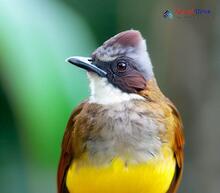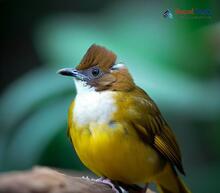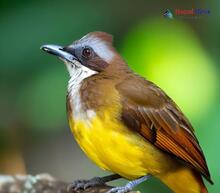Bird lovers and scientists share a common fascination for the wonders that nature presents. In the breathtaking landscapes of Nepal, a mysterious group of birds known as the Alophoixus genus captures our imagination with their complex evolutionary pasts and ecological roles. In this article, let's uncover the exciting world of Alophoixus birds while learning about their evolutionary tree, classification, appearance, ecology, and presence in Nepal.
Evolutionary Tree and Classification:
At first glance, Alophoixus birds might resemble bulbuls due to some similarities in how they look. But if you take a closer look at their DNA and listen to their songs, you'll see that Alophoixus is actually a separate genus. The evolutionary background of these birds is still being studied today. However, one important piece of research found strong evidence pointing toward all Alophoixus birds having a single common ancestor.
Classification-wise, Alophoixus belongs to the Pycnonotidae family alongside bulbuls. The genus includes several species such as the Brown-cheeked Fulvetta (Alophoixus bres), the more elusive Ochraceous Bulbul (Alophoixus ochraceus), and the Yellow-browed Bulbul (Alophoixus phaeocephalus). Small differences in size, color patterns, and habitat preferences help tell these species apart.
Appearance and Ecology
When it comes to body features, Alophoixus species have medium-sized bodies with sturdy builds. They are usually covered in olive green or brown feathers that sometimes show highlight markings on their heads, wings, or tails. Many of them even sport a visible crest or tuft on top of their heads. As they are mainly insect-eaters, Alophoixus birds typically have sharp beaks to effectively catch their prey.
Alophoixus birds can be found in different environments, from steamy rainforests to the foothills of the towering Himalayas. They primarily eat insects, which makes them an essential part of maintaining nature's balance by keeping the insect population under control. While some Alophoixus species enjoy dense forest floors, others like to hang out in more open woodland spaces.
Nepal's Alophoixus:
In Nepal, you can find a few kinds of Alophoixus birds, with the Brown-cheeked Fulvetta being the most widespread. Places like the Shivapuri Nagarjun National Park and Annapurna Conservation Area are perfect for birdwatching enthusiasts to see these delightful creatures up close. The addition of Alophoixus increases Nepal's bird diversity and plays a vital role in its thriving ecosystems.
To sum it all up, the captivating Alophoixus genus offers us an amazing group of birds that each bring something unique to Nepal's natural world. As we continue exploring their classification, appearance, and ecology through research, we'll undoubtedly uncover more outstanding information about them. For both bird enthusiasts and researchers alike, observing these incredible creatures only deepens our love and admiration for the remarkable wonders that nature has to offer.




